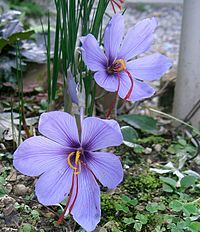
Photo from wikipedia
Saffron "Crocus sativus" is a plant of the Iridaceae family. Its therapeutic virtues have been known since antiquity; it is used in traditional medicine and culinary preparations. It is also… Click to show full abstract
Saffron "Crocus sativus" is a plant of the Iridaceae family. Its therapeutic virtues have been known since antiquity; it is used in traditional medicine and culinary preparations. It is also known for its use in cosmetics because of its beneficial pharmacological activities for human skin. In particular, saffron tepals are the main by-product of saffron processing; they contain several bioactive compounds such as mineral agents, anthocyanins, monoterpenoids, carotenoids, flavonoids, and flavonols (kaempferol). This review aims to describe the different properties of saffron flower tepals, including their botanical characteristics, phytochemical composition, biological activities, and cosmetology and perfumery uses.
Journal Title: Critical reviews in food science and nutrition
Year Published: 2023
Link to full text (if available)
Share on Social Media: Sign Up to like & get
recommendations!